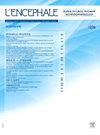人格障碍替代模型的稳定性:以Covid-19相关情况为例
IF 1
4区 医学
Q4 NEUROSCIENCES
Encephale-Revue De Psychiatrie Clinique Biologique et Therapeutique
Pub Date : 2025-02-14
DOI:10.1016/j.encep.2024.11.016
引用次数: 0
摘要
目的与范围:本文旨在探讨人格障碍替代模型(AMPD)中两个关键水平(标准A和标准B)之间的关系。具体来说,它检查了人格功能水平(LPF)和病理人格维度(PPD)之间的衔接,以了解它们各自对人格障碍(PD)诊断的贡献。方法:我们分析了在COVID-19大流行和随后的封锁之前(n=124)和之后(n=126)通过LPFS-BR和PID-5-BF仪器收集的两个随机样本的非临床参与者的数据。进行中介分析以阐明LPF和PPD在pd评估中的相互作用。结果:研究结果显示,LPF水平存在显著的强度差异(P0.92),总体PD严重程度和PPD特征均具有高度稳定性(P < 0.05)。回归分析允许我们通过中介模型检查锁定、身份和脱离对PD严重程度的综合影响。结果表明,身份在封闭和疏离的作用中起中介作用,疏离也有直接影响。讨论:这些结果表明,虽然AMPD的某些方面是上下文敏感的,但PPD可能通过直接和间接机制抵消这些波动。本文章由计算机程序翻译,如有差异,请以英文原文为准。
The stability of the alternative model of personality disorders: Example of the situation related to Covid-19
Aim and scope
This article aims to explore the relationships between two key levels (Criteria A and B) in the Alternative Model of Personality Disorders (AMPD). Specifically, it examines the articulation between the level of personality functioning (LPF) and the pathological personality dimensions (PPD) to understand their respective contributions to personality disorder (PD) diagnosis.
Method
We analyzed data collected through the LPFS-BR and PID-5-BF instruments from two randomized samples of non-clinical participants, gathered both before (n = 124) and after (n = 126) the COVID-19 pandemic and subsequent lockdown. Mediation analyses were conducted to clarify how LPF and PPD interact in the assessment of PDs.
Results
Findings indicate notable intensity differences in LPF levels (P < 0.001, Cohen's d > 0.92), alongside high stability in both overall PD severity and PPD traits (P > 0.05). Regression analysis allowed us to examine the combined effects of Lockdown, Identity, and Detachment on PD severity through mediation modelling. Results suggest that Identity mediates the effects of both Lockdown and Detachment, with Detachment also having a direct impact.
Discussion
These results indicate that while certain aspects of the AMPD are context-sensitive, the PPD may offset these fluctuations through both direct and indirect mechanisms.
求助全文
通过发布文献求助,成功后即可免费获取论文全文。
去求助
来源期刊
CiteScore
4.60
自引率
7.40%
发文量
162
审稿时长
6-12 weeks
期刊介绍:
Une revue française de renommée internationale.
- Un comite de rédaction représentant tous les aspects de la prise en charge psychiatrique du patient.
- Une sélection rigoureuse d''articles faisant l''objet de plusieurs expertises.
- Des travaux d''auteurs et de chercheurs de renommée internationale.
- Des indexations dans les grandes bases de données (Current Contents, Excerpta Medica, etc.).
- Un facteur d''impact qui témoigne de la grande notoriété de la revue.
La tribune des publications originales de haut niveau.
- Une très grande diversité des sujets traités, rigoureusement sélectionnés à travers des sommaires dynamiques :
- des éditoriaux de médecins référents,
- une revue de presse sur les actualités internationales,
- des articles originaux pour approfondir vos connaissances,
- des mises au point et des cas cliniques pour engager votre réflexion sur les indications et choix possibles au travers de mises en situation clinique,
- des dossiers thématiques pour faire le tour d''une question.
- L''actualité de l''AFPB : L''Encéphale publie régulièrement des comptes rendus de l''Association française de psychiatrie clinique.

 求助内容:
求助内容: 应助结果提醒方式:
应助结果提醒方式:


